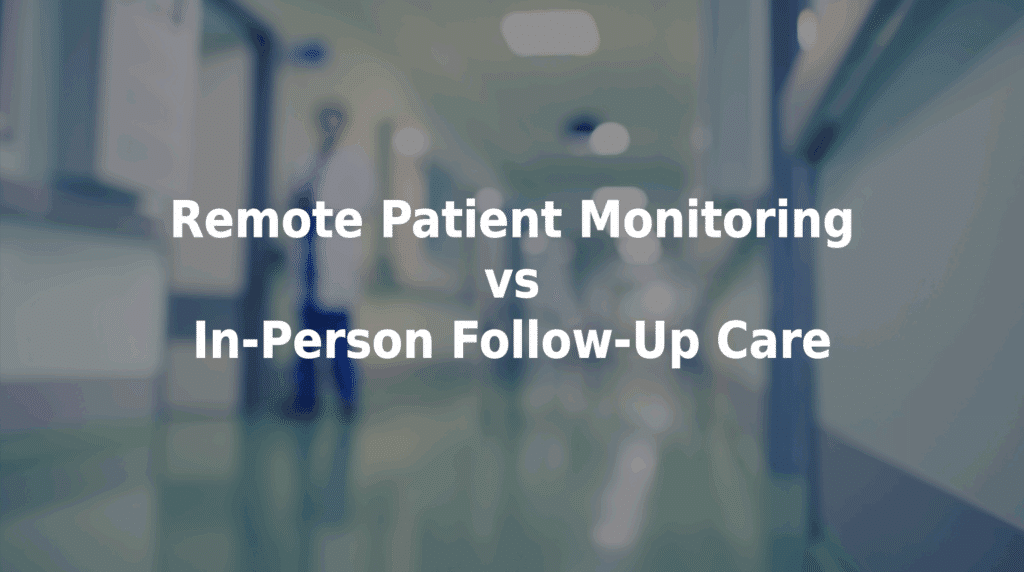Remote Patient Monitoring vs In-Person Follow-Up Care
Hospital administrators who want to move toward value-based treatment must carefully evaluate the benefits and limitations of remote patient monitoring vs in-person follow-up care. Many hospitals are looking for scalable solutions that reduce readmissions, improve patient engagement, and optimize clinical workflows. TriageLogic’s remote patient monitoring (RPM) platform is built to complement — and in some cases outperform — traditional follow-up visits, delivering timely insights and real-time interventions that in-person models simply can’t match.
In-Person Follow-Up: The Traditional Standard
In-person follow-up care has long been the foundation of post-discharge treatment. After hospitalization, patients typically return to a clinic or physician’s office within one to two weeks for an evaluation. These visits are valuable for physical examinations, patient education, and adjusting treatment plans. However, they also come with challenges.
- Delayed detection of complications between discharge and appointment.
- Patient barriers like transportation, mobility, or scheduling conflicts.
- Limited continuity in monitoring vitals and symptoms.
- Increased burden on outpatient staff and clinic availability.
These limitations can be especially problematic for patients managing chronic conditions or recent acute episodes.
Remote Patient Monitoring: A Proactive Alternative
TriageLogic’s RPM program transforms follow-up care. Patients are equipped with biometric devices — such as blood pressure cuffs, pulse oximeters, and glucose monitors — that transmit real-time data directly to clinical teams. Combined with 24/7 nurse triage, this model provides ongoing oversight and faster interventions.
Key benefits include:
- Daily health tracking, not just periodic check-ins.
- Real-time alerts when vitals fall outside safe ranges.
- Clinical triage staff who respond immediately and escalate care when necessary.
- Increased patient engagement, with guided support and regular contact.
- Better readmission prevention, through early identification of risk factors.
RPM vs. In-Person Care: A Side-by-Side Comparison
| Feature | In-Person Follow-Up | Remote Patient Monitoring (TriageLogic) |
|---|---|---|
| Frequency of Monitoring | Every 1–2 weeks | Daily or continuous |
| Early Detection of Issues | ❌ Limited | ✔️ Immediate through real-time alerts |
| Care Coordination | ⚠️ Fragmented | ✔️ Integrated with triage and EHR |
| Accessibility for Patients | ⚠️ Limited by location | ✔️ Home-based, accessible care |
| Nurse Triage Oversight | ❌ None | ✔️ 24/7 RN monitoring and patient outreach |
| Impact on Readmissions | ⚠️ Variable | ✔️ Demonstrated reduction |
Note: ✔️ = Strong capability | ⚠️ = Limited | ❌ = Not provided
When to Use RPM, In-Person Care — or Both
In most cases, remote monitoring doesn’t replace in-person follow-up — it enhances it. For example:
- Use RPM immediately after discharge to monitor recovery and detect early warning signs.
- Follow this with in-person visits for physical assessments, lab work, or complex care planning.
- Combine both approaches for patients with chronic conditions or recent acute episodes requiring long-term care management.
TriageLogic’s RPM platform is designed to work seamlessly alongside existing hospital workflows, meet HIPAA requirements for telehealth, and complement your in-person resources instead of compete with them.
Aligning With Value-Based Care
Hospitals using RPM benefit from better HEDIS performance, lower ER utilization, and reduced CMS penalties. With consistent monitoring, patients are less likely to fall through the cracks between visits — a key component of successful value-based contracts.
Choose a Smarter Model for Follow-Up Care
TriageLogic helps hospital administrators enhance traditional care pathways with proactive, tech-enabled solutions. Whether you’re looking to reduce readmissions, improve patient satisfaction, or streamline care coordination, our RPM platform delivers results.
Learn more about a program by contacting us today!

